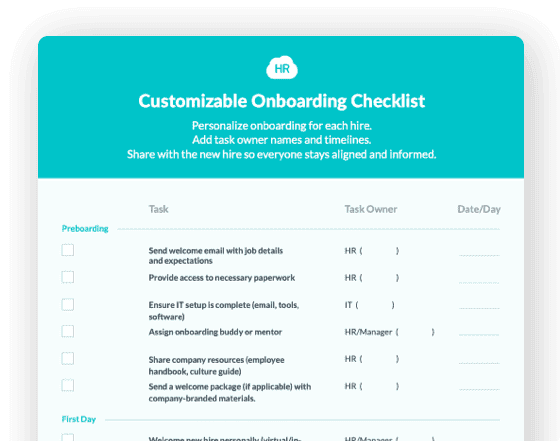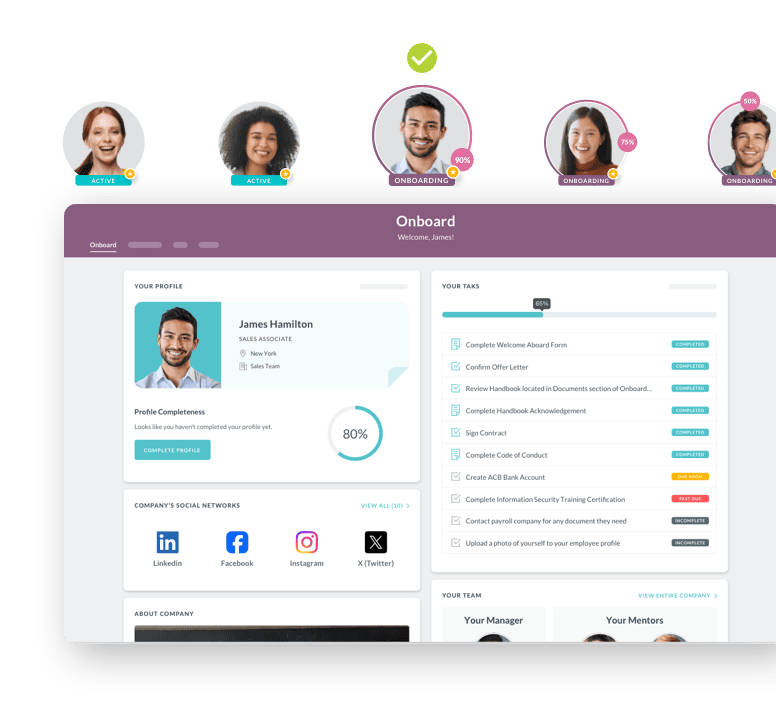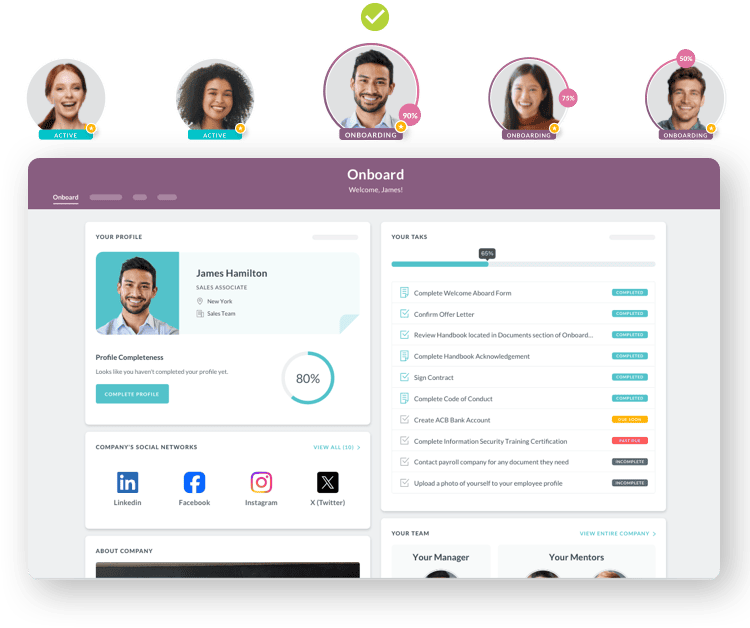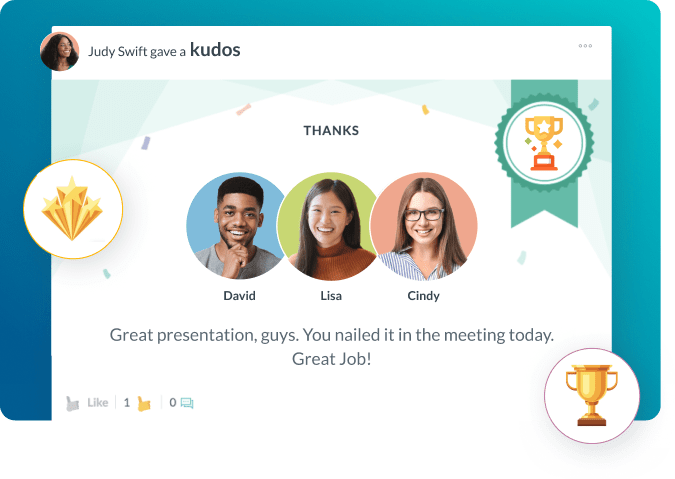Job Sourcing
- Why Strategic Job Sourcing Delivers Real Business Value
- Key Points: What Makes Job Sourcing Effective
- Sourcing Channels and Methods Comparison
- Best Practices: Building a High Performance Sourcing Function
- Pitfalls to Avoid: Common Sourcing Mistakes That Undermine Results
- Industry Applications: How Different Sectors Leverage Job Sourcing
- Implementation Plan: Building Your Job Sourcing Program
- Future Outlook: How Job Sourcing Continues to Evolve

 Cut onboarding time
by 60%—here's the
Ultimate Checklist
that helped do it.
Cut onboarding time
by 60%—here's the
Ultimate Checklist
that helped do it.

Job sourcing represents the proactive search for qualified candidates to fill current or future positions within your organization. Unlike traditional recruiting where you post a job and wait for applications, job sourcing flips the script. You actively seek out potential employees, engage them in meaningful conversations, and build relationships long before you need to fill a specific role. This approach has become essential in today's competitive talent acquisition landscape, where 63% of organizations consider talent shortage their biggest challenge. The difference between companies that thrive and those that struggle often comes down to one factor: their ability to identify and connect with top talent before their competitors do. Smart organizations understand that waiting for the perfect candidate to apply is no longer a viable strategy. They've embraced sourcing as a core business function that directly impacts their ability to innovate, grow, and maintain competitive advantage in their markets.
Why Strategic Job Sourcing Delivers Real Business Value
The business case for job sourcing extends far beyond simply filling empty desks. When you implement a robust sourcing strategy, you gain access to a significantly larger talent pool. According to LinkedIn, passive candidates account for 75% of the workforce, meaning only 25% are actively job hunting. This means three out of four qualified professionals you need might never see your job posting, no matter how compelling it is. By actively sourcing candidates, you tap into this hidden majority and dramatically improve your chances of finding the perfect fit. Quality candidates are worth the extra effort. Research from SHRM shows the average cost per hire reaches £316.31, with an average time to hire of 42 days. These numbers climb even higher when you make the wrong hire and need to restart the process. Strategic sourcing helps you reduce these costs by building a pipeline of pre qualified candidates who are genuinely interested in your organization. You've already done the hard work of relationship building, so when a position opens, you can move quickly to secure top talent before they're swept up by competitors. The competitive advantage goes beyond speed and cost. Organizations that excel at job sourcing build employer brands that attract the best professionals in their fields. They create seamless recruitment processes that make candidates feel valued from first contact through onboarding, setting the stage for long term employee engagement and retention.
Key Points: What Makes Job Sourcing Effective
Before diving into specific tactics and frameworks, you need to understand the fundamental principles that separate successful sourcing programs from those that waste time and resources:
-
Proactive outreach transforms your talent pipeline. Instead of reacting to urgent hiring needs, you continuously identify and engage potential candidates, creating a ready pool of qualified professionals who already understand your company culture and value proposition.
-
Relationship building drives long term results. The best sourcing isn't transactional. You invest time in authentic conversations, provide value even when you're not hiring, and maintain connections that pay dividends when the right opportunity arises.
-
Data driven decision making improves outcomes. Track which sourcing channels deliver the highest quality candidates, measure time to fill by source, and continuously refine your approach based on concrete metrics rather than gut feelings.
-
Diversity expands through intentional sourcing. Organizations with significant ethnic diversity are 39% more likely to outperform businesses with limited representation. Active sourcing lets you deliberately reach underrepresented talent pools that traditional job postings might miss.
-
Technology amplifies human judgment. Modern recruitment tools handle repetitive tasks like initial screening and database searches, freeing your team to focus on the high value work of building relationships and assessing cultural fit.
-
Passive candidates require different engagement strategies. These professionals aren't actively job hunting, so your messaging must focus on career growth, exciting challenges, and unique opportunities rather than simply filling an open position.
Sourcing Channels and Methods Comparison
Understanding where to invest your sourcing efforts requires comparing the strengths and limitations of different channels. This framework helps you allocate resources strategically:
|
Sourcing Channel |
Best For |
Time Investment |
Quality Level |
Cost Factor |
|
LinkedIn and professional networks |
Professional roles, tech positions, executive searches |
Medium |
High |
Low to medium |
|
Employee referrals |
Cultural fit, trusted candidates, hard to fill positions |
Low |
Very high |
Low |
|
Industry events and conferences |
Specialized skills, relationship building, employer branding |
High |
High |
Medium to high |
|
Social media platforms |
Creative roles, younger demographics, company culture showcase |
Medium |
Medium |
Low |
|
Niche job boards |
Industry specific roles, technical positions, specialized skills |
Low to medium |
Medium to high |
Medium |
|
Campus recruiting |
Entry level positions, intern programs, future leadership pipeline |
High |
Medium |
Medium |
|
Recruitment agencies |
Hard to find talent, executive positions, time sensitive needs |
Low for you |
Variable |
High |
Best Practices: Building a High Performance Sourcing Function
Success in job sourcing comes from implementing proven practices consistently across your organization. These strategies separate effective programs from those that generate activity without results.
Start by developing detailed candidate profiles before you begin searching. Too many organizations jump straight into sourcing without clearly defining what success looks like. Take time to understand not just the technical requirements, but also the soft skills, cultural attributes, and growth potential that matter for each role. Work closely with hiring managers to create comprehensive profiles that guide your search and help you quickly identify the right matches. Diversify your sourcing channels strategically. Don't rely on the same old social media platforms. Find platforms connected to the industry you're recruiting for, and look for people using them to have smart, relevant conversations. If you're impressed by someone's questions, answers, or posts, you've potentially identified a valuable employee. The key is meeting candidates where they already spend their time rather than expecting them to come to you.
Leverage your current employees as sourcing partners. Your team members know talented professionals in their networks who might be perfect for your organization. Implement a structured employee referral program that makes it easy for staff to recommend candidates. Provide clear guidelines, offer meaningful incentives, and close the feedback loop by letting referrers know what happened with their recommendations.
Invest in technology that scales your efforts. AI enhanced sourcing tools can sift through thousands of profiles to identify candidates who match your criteria, dramatically reducing the time your team spends on manual searches. However, technology should amplify human judgment, not replace it. Use automation for initial screening and data management, but maintain the personal touch in your actual candidate interactions.
Maintain consistent communication with sourced candidates. Even when you're not actively hiring, stay in touch with promising professionals in your pipeline. Share relevant industry insights, congratulate them on career milestones, and periodically check in about their career goals. This ongoing engagement keeps your organization top of mind when they're ready to consider new opportunities.
Measure and optimize your sourcing performance continuously. Track source of hire, quality of hire by channel, time to fill, and candidate satisfaction metrics. Use this data to double down on what works and eliminate activities that consume resources without delivering results. The best sourcing teams treat their work like any other business function, using analytics to drive continuous improvement.


Pitfalls to Avoid: Common Sourcing Mistakes That Undermine Results
Even experienced organizations fall into sourcing traps that waste time and damage their employer brand. Understanding these pitfalls helps you avoid them.
Many companies make the mistake of starting sourcing efforts only when a position opens. This reactive approach defeats the entire purpose of sourcing. By the time you identify, engage, and cultivate relationships with passive candidates, the immediate hiring need may have passed or been filled through less optimal channels. Effective sourcing is an always on activity that builds pipeline continuously, not a crisis response when vacancies arise.
Treating all candidates the same regardless of their status represents another critical error. Passive job seekers are currently employed and not actively looking for new jobs, but may be open to good career opportunities. They require different messaging and engagement strategies than active candidates. Generic recruitment pitches that focus on job requirements rather than career growth opportunities will fall flat with this audience.
Failing to provide timely follow up damages your sourcing efforts and your employer brand. In today's transparent labor market, candidates share their experiences widely. When you contact someone, express interest, and then disappear without explanation, you create negative impressions that spread through professional networks. Even when a candidate isn't the right fit, professional and prompt communication protects your reputation.
Overlooking diversity in your sourcing strategy perpetuates homogenous workforces and limits your access to top talent. If you only source from the same networks, schools, and companies, you'll keep getting the same types of candidates. Deliberately expanding your sourcing channels to reach underrepresented groups requires intentional effort, but it pays dividends in innovation, market insight, and business performance.
Neglecting to align sourcing with your onboarding capabilities creates bottlenecks that frustrate candidates and hiring managers alike. There's no point filling your pipeline with excellent candidates if your organization can't move them through the hiring process efficiently or provide a strong onboarding experience that sets them up for success.
Industry Applications: How Different Sectors Leverage Job Sourcing
Job sourcing strategies must adapt to the unique challenges and opportunities within different industries. Here's how leading organizations apply sourcing principles in various contexts.
In the technology sector, where specialized skills are in high demand and talent shortages are acute, companies have become creative with their sourcing approaches. Tech firms actively participate in GitHub communities, attend hackathons, and monitor technical forums to identify developers with the right skills and mindset. They've learned that the best engineers often aren't actively job hunting, so they build relationships through technical content, open source contributions, and developer focused events. One software company reduced their time to hire for senior developers from 67 days to 31 days by implementing a continuous sourcing program that engaged passive candidates months before positions opened.
Healthcare organizations face the dual challenge of sourcing for highly regulated clinical positions while also competing for administrative and IT talent. Progressive healthcare systems have developed partnerships with nursing schools and medical programs to build talent pipelines years in advance. They maintain ongoing relationships with clinical professionals through continuing education programs, industry conferences, and alumni networks. For non clinical roles, they emphasize mission driven recruiting that appeals to candidates who want meaningful work that improves patient outcomes. This approach has helped healthcare organizations overcome recruitment challenges specific to their industry.
Manufacturing companies have successfully used apprenticeship programs and partnerships with technical colleges to source skilled trades workers. Rather than competing for the limited pool of experienced machinists, welders, and technicians, they've invested in building relationships with educational institutions and offering training programs that develop the exact skills they need. This long term sourcing strategy addresses both immediate hiring needs and the industry's demographic challenges as experienced workers retire.
Implementation Plan: Building Your Job Sourcing Program
Creating an effective sourcing function requires systematic planning and execution. Follow these steps to build a program that delivers consistent results.
Begin by assessing your current state and defining clear objectives. Review your existing hiring processes to understand where qualified candidates come from today. Analyze your time to fill, cost per hire, and quality of hire metrics by source. Identify which positions are hardest to fill and where strategic sourcing could make the biggest impact. Set specific, measurable goals such as reducing time to fill by 30% for technical positions or building a pipeline of 50 qualified candidates for critical roles.
Next, develop your ideal candidate profiles for key positions. Work with hiring managers and top performers to document the skills, experiences, and attributes that predict success in each role. Go beyond job descriptions to understand the growth trajectory, cultural fit factors, and motivations that matter. These profiles become your north star for sourcing decisions.
Choose and implement the right technology stack to support your sourcing efforts. At minimum, you need an applicant tracking system that manages candidate relationships effectively. Consider AI powered sourcing tools that can identify candidates across multiple platforms, and candidate relationship management software that helps you maintain ongoing engagement. Ensure your HR technology integrates smoothly with your existing systems.
Train your team on effective sourcing techniques. Not everyone naturally excels at the detective work and relationship building that sourcing requires. Provide training on Boolean search strategies, crafting compelling outreach messages, handling objections from passive candidates, and using your technology tools effectively. Create playbooks that document your best practices and make it easy for new team members to ramp up quickly.
Launch targeted sourcing campaigns for priority positions. Start with a few key roles rather than trying to source for everything at once. Test different channels, messaging approaches, and engagement strategies. Track what works and what doesn't. Use these initial campaigns to refine your approach before scaling across the organization.
Establish metrics and reporting cadence to track progress. Define key performance indicators such as pipeline conversion rates, source of hire, candidate response rates, and quality of hire by source. Create dashboards that give visibility to recruiting leaders and hiring managers. Schedule regular reviews to assess performance, identify trends, and adjust strategies based on data.
Scale and optimize based on results. As you prove the value of sourcing through early wins, expand the program to additional roles and departments. Continue refining your approach based on what the data tells you about which strategies deliver the best candidates most efficiently.
Future Outlook: How Job Sourcing Continues to Evolve
The future of job sourcing is being shaped by technological innovation, changing workforce expectations, and demographic shifts that are fundamentally altering talent markets. Understanding these trends helps you position your organization for continued success.
Artificial intelligence will play an increasingly sophisticated role in identifying and engaging candidates. Rather than simply matching keywords, next generation AI tools will assess career trajectories, predict candidate interest in specific opportunities, and even recommend optimal outreach timing. These capabilities will allow sourcing teams to work at a scale previously impossible, while maintaining the personalization that passive candidates expect. However, as the COVID pandemic accelerated, skills have an increasingly short shelf life, making it more challenging to determine which skills to hire for. This means sourcing strategies must become more focused on learning agility and adaptability rather than perfect skill matches.
Remote work has permanently expanded talent pools beyond geographic boundaries. Organizations can now source candidates globally for many positions, dramatically increasing competition for top talent while also opening access to professionals who were previously out of reach. This shift requires rethinking traditional sourcing strategies that relied heavily on local networks and geographic proximity. It also creates opportunities for organizations willing to embrace distributed teams and build inclusive cultures that support remote workers effectively.
Diversity, equity, and inclusion will move from nice to have to business critical in sourcing strategies. The majority of workers aged 18 to 34 said they would consider turning down a job offer or leaving a company if their manager didn't support DEIB initiatives. Organizations that fail to demonstrate authentic commitment to diversity through their sourcing practices will struggle to attract younger talent who prioritize these values. This means deliberately expanding sourcing channels, addressing bias in screening processes, and building cultures where diverse talent can thrive.
The line between sourcing and employer branding will continue to blur. Every interaction with potential candidates shapes perceptions of your organization. Sourcing teams must think like marketers, creating compelling content, building communities, and delivering experiences that position their employers as destinations for top talent. Social media, employee testimonials, and authentic storytelling will become as important to sourcing success as technical recruiting skills.
Skills based hiring will transform how organizations approach sourcing. Rather than requiring specific degrees or years of experience, forward thinking companies will focus on demonstrated capabilities and potential. This opens opportunities to source from non traditional talent pools, including career changers, veterans, and candidates from diverse educational backgrounds. It also requires developing better assessment tools to evaluate skills objectively and creating clear pathways for talented people to contribute regardless of their backgrounds.
Preparing for these changes means investing in continuous learning for your sourcing team, building flexible processes that can adapt as markets shift, and maintaining a candidate centric approach that respects the choices and preferences of today's professionals. Organizations that embrace these trends while staying grounded in the fundamentals of relationship building and authentic engagement will continue to win the competition for exceptional talent.
 Discover how our HR solutions streamline onboarding, boost employee engagement, and simplify HR management
Discover how our HR solutions streamline onboarding, boost employee engagement, and simplify HR management
Keep Reading
From Manual to Automated: A Complete Guide to Digitizing Employee Onboarding for Large Organizations
Sarah Chen, Director of HR at a 7,000-employee healthcare organization, starts her Monday
Enterprise HR Software in 2025: Why Traditional Enterprise Platforms Fall Short and What Actually Works
Traditional enterprise human resources software systems promise comprehensive solutions
AI in Onboarding: Complete Guide for 2026
You’ve probably been hearing this multiple times a day — AI is transforming HR. But
Ready to streamline your onboarding process?
Book a demo today and see how HR Cloud can help you create an exceptional experience for your new employees.







